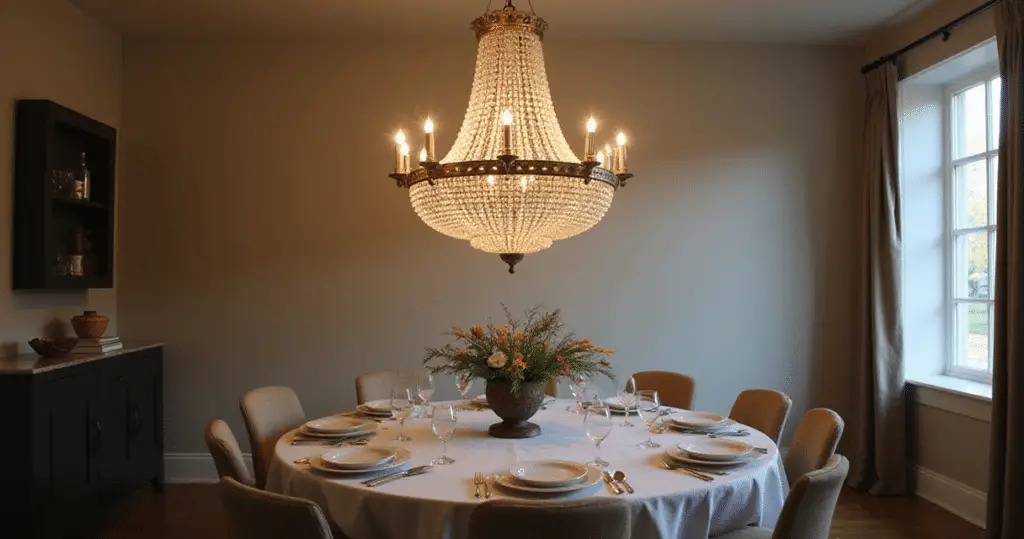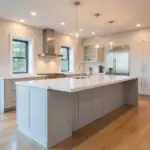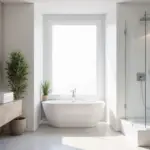Picture this: the soft glow of perfectly positioned light dancing across your dinner table, casting an inviting warmth that transforms an ordinary meal into an extraordinary experience. Your dining room lighting over table isn’t just about visibility—it’s the invisible conductor orchestrating every conversation, every shared laugh, every memorable moment that unfolds in this sacred space of your home.
Yet so many dining rooms suffer from lighting that feels like an afterthought. Harsh overhead glare that makes everyone squint. Dim shadows that leave half the table in darkness. Fixtures that hang awkwardly, disrupting the flow of conversation. These common missteps can turn what should be your home’s most welcoming gathering place into a space that feels uncomfortable and uninviting.
The artistry of exceptional dining room lighting over table lies in understanding that illumination is both science and soul. It’s about creating layers of light that adapt to your life—bright enough for homework sessions, intimate enough for anniversary dinners, and flexible enough for everything in between. Through these 18 carefully curated insights, you’ll discover how to transform your dining space into a luminous haven that enhances every meal and creates the perfect backdrop for life’s most cherished moments.
1. Master the Art of Proportional Fixture Sizing
The foundation of stunning dining room lighting over table begins with understanding the delicate dance between your fixture and your dining table. When these two elements exist in perfect proportion, they create a visual harmony that feels effortless and intentional. A fixture that’s too small disappears against a substantial table, while an oversized piece can overwhelm the space and obstruct sightlines across your dining surface.
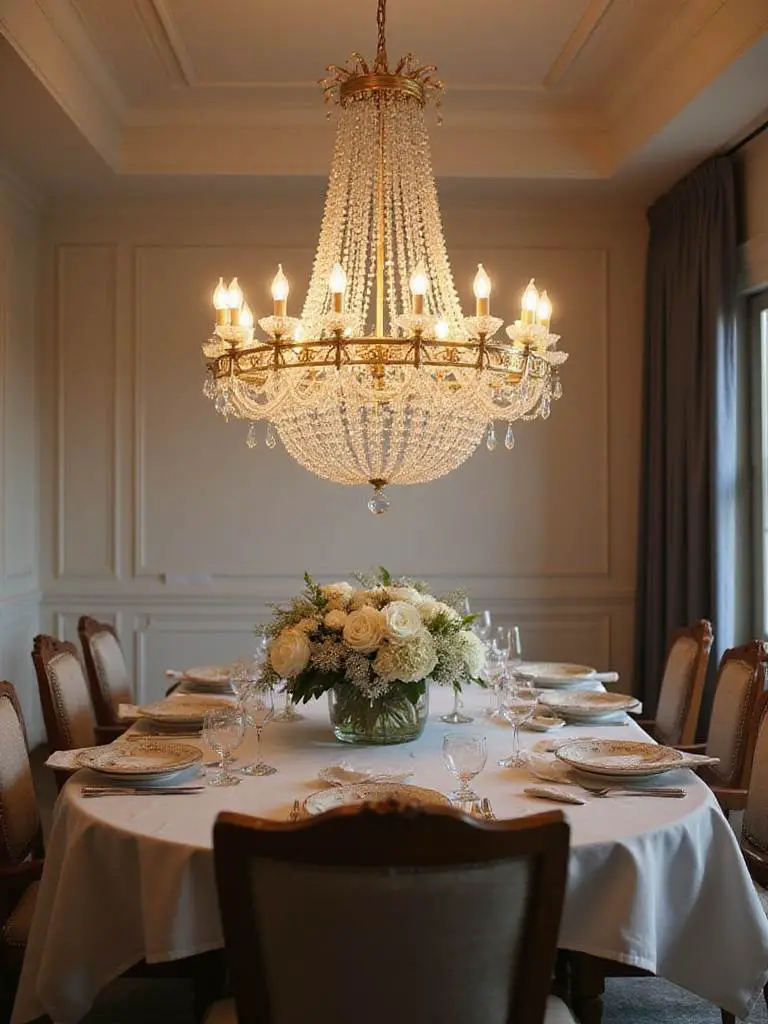
Professional designers rely on the two-thirds rule as their starting point: your fixture’s width should measure between half and two-thirds of your table’s width. For a 60-inch rectangular table, this translates to a fixture spanning 30 to 40 inches. But here’s where the magic happens—this isn’t just about mathematical precision. Consider the visual weight of your chosen piece. An ornate crystal chandelier carries more presence than a minimalist linear pendant, even if they share identical dimensions.
Beyond the numbers lies the crucial consideration of your room’s architecture and your table’s proportions. A chunky farmhouse table can support a more substantial fixture than a delicate glass-top piece. Similarly, high ceilings allow for fixtures with greater vertical presence, while standard eight-foot ceilings call for more restrained proportions.
- Measure twice, purchase once: Document your table’s exact dimensions and ceiling height before shopping
- Consider visual weight: Dense, ornate fixtures appear larger than open, minimalist designs
- Account for room scale: Factor in your dining room’s overall size, not just the table dimensions
Look closely and you’ll notice the subtle relationship between fixture scale and room comfort—when proportions align perfectly, the space feels naturally balanced and inviting.
2. Perfect Your Fixture Height for Optimal Comfort
The vertical positioning of your dining room lighting over table determines whether your dining experience feels intimate and welcoming or harsh and uncomfortable. This critical measurement affects everything from conversation flow to food presentation, making it one of the most important decisions in your lighting design. Too low, and your fixture becomes a visual barrier that fragments the dining experience; too high, and it loses its ability to create that essential pool of focused light.
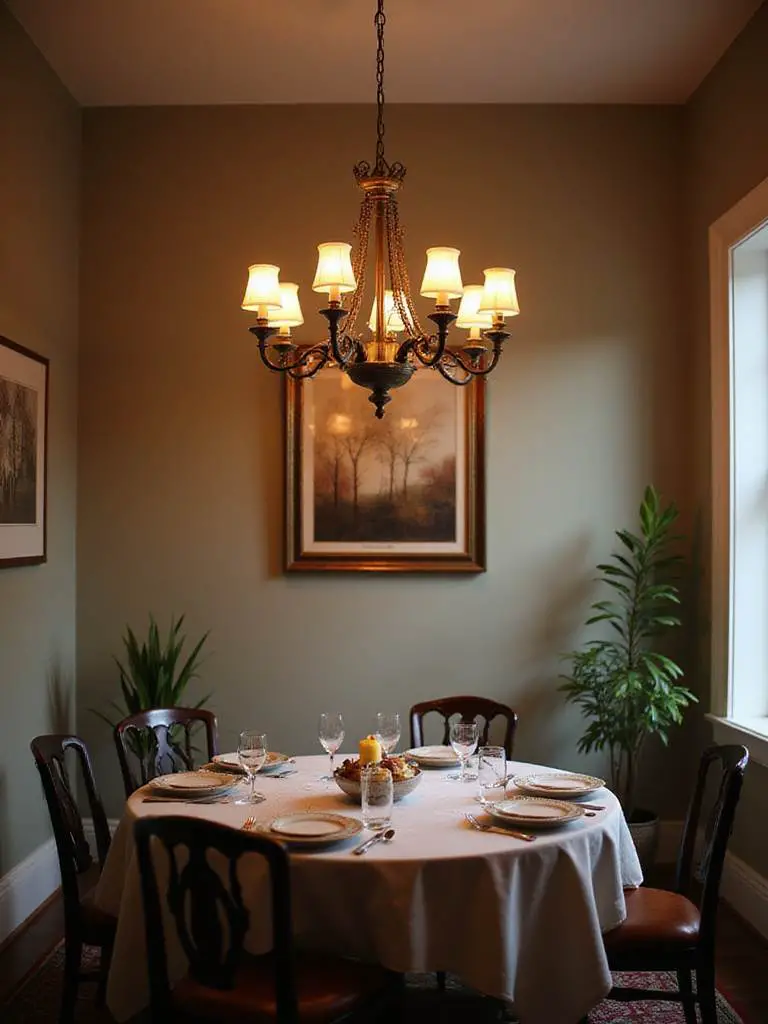
The golden standard places your fixture’s bottom edge 30 to 36 inches above your table surface for standard eight-foot ceilings. But the real test happens when you sit down. From every seat at your table, you should see the fixture without experiencing direct glare from exposed bulbs. This seated perspective reveals whether your chosen height truly serves your dining comfort or merely follows arbitrary rules.
For rooms with soaring ceilings, add three inches of hanging length for every additional foot of ceiling height. A ten-foot ceiling calls for your fixture to hang 36 to 42 inches above the table. This adjustment maintains the intimate relationship between light and dining surface while honoring your room’s vertical grandeur.
- Test from seated positions: Sit at every chair to ensure comfortable sightlines
- Adjust for ceiling height: Higher ceilings require proportionally lower-hanging fixtures
- Consider fixture depth: Deeper fixtures may need slight height adjustments to prevent head bumps
The magic of this piece lies in its ability to create an invisible boundary—defining your dining space without overwhelming it.
3. Calculate Your Ideal Lumen Output for Perfect Ambiance
Understanding lumens transforms your approach to dining room lighting over table from guesswork to precision. These measurable units of light output determine whether your dining space feels energizing and functional or soft and intimate. The key lies in selecting fixtures that provide enough total lumens for clear visibility while maintaining the flexibility to dim down for atmospheric dining.
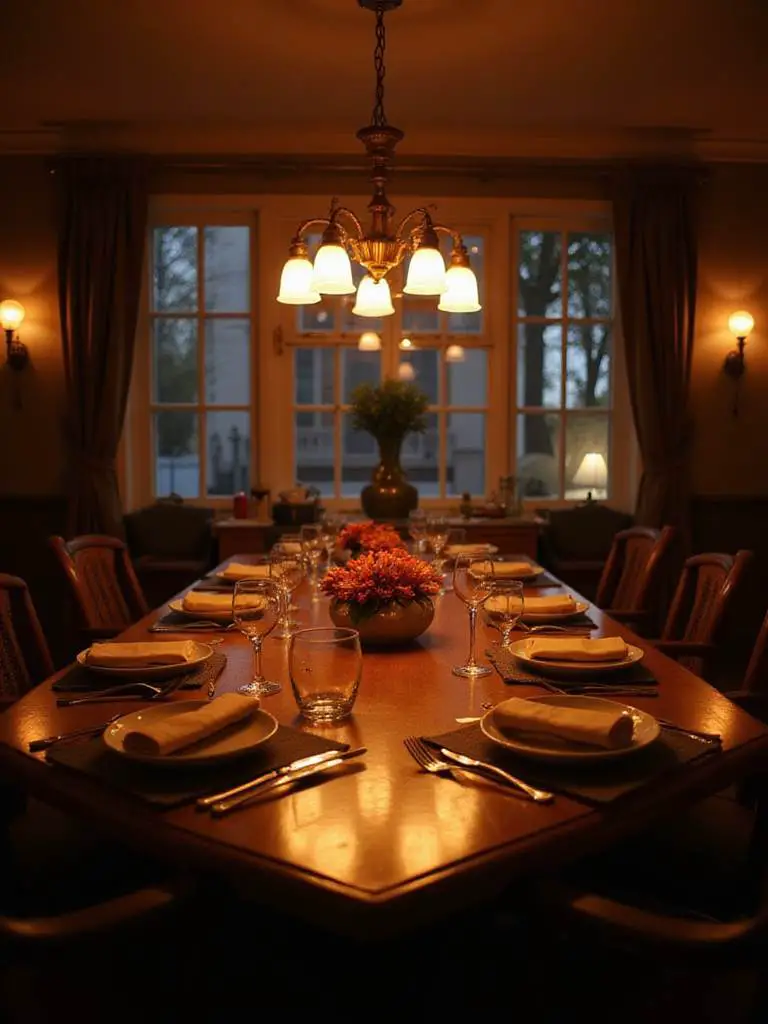
Start with your room’s square footage and multiply by 20 to 40 lumens per square foot for your baseline calculation. A 120-square-foot dining room requires between 2,400 and 4,800 lumens for optimal general illumination. However, this number serves as your maximum—the beauty of proper dining room lighting lies in your ability to scale down to 800 to 1,200 lumens for intimate occasions through dimming controls.
The quality of your lumens matters as much as the quantity. LED fixtures with high Color Rendering Index (CRI) ratings above 90 ensure that your carefully prepared meals appear vibrant and appetizing under your chosen light levels. This technical specification directly impacts how colors appear, making the difference between food that looks fresh and appealing versus dull and unappetizing.
- Calculate your baseline: Room square footage × 30 lumens = starting point
- Plan for flexibility: Choose fixtures that can dim to 25% of maximum output
- Prioritize quality: High CRI ratings (90+) ensure accurate color representation
What makes this design special is the way it adapts throughout your day—bright enough for morning coffee and homework, intimate enough for candlelit conversations.
4. Select the Perfect Color Temperature for Appetizing Appeal
The warmth of your dining room lighting over table profoundly influences both the visual appeal of your food and the emotional comfort of your guests. Measured in Kelvin, color temperature ranges from warm amber tones to cool daylight hues. For dining spaces, the sweet spot falls between 2200K and 3000K, where light feels naturally warm without appearing overly yellow or orange.
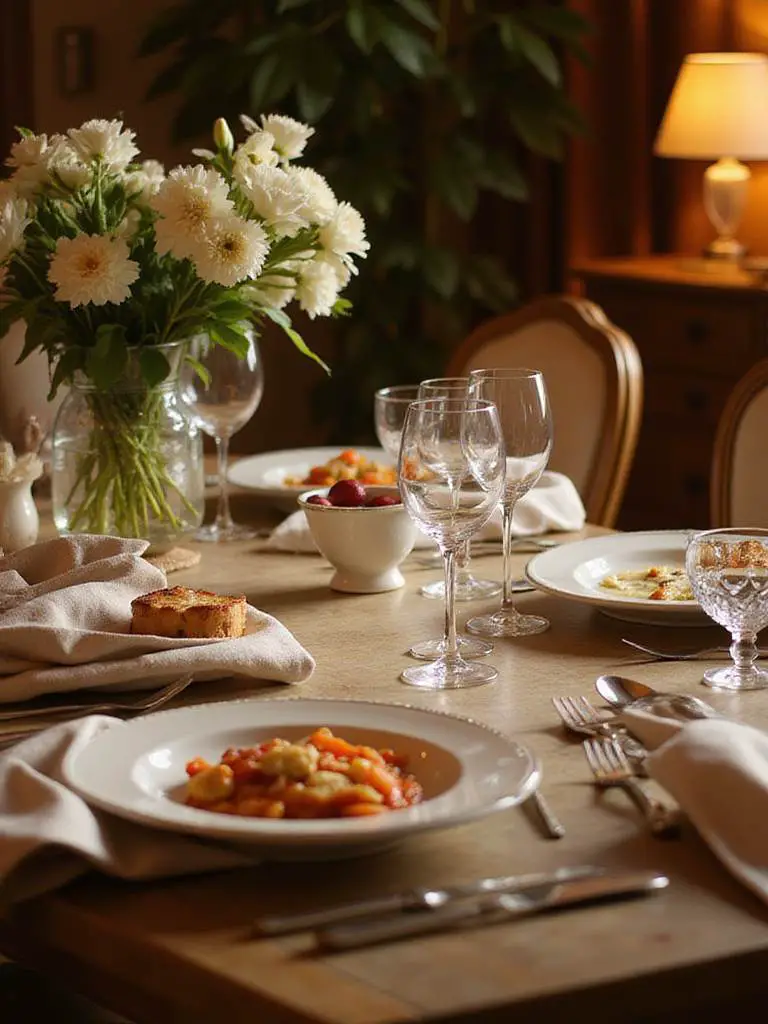
At 2700K, your lighting strikes an ideal balance—warm enough to create a cozy, welcoming atmosphere while maintaining sufficient clarity to showcase food in its most appealing light. This temperature enhances the natural reds and golds in roasted meats, fresh vegetables, and warm bread, making every meal more visually enticing. Restaurant designers consistently choose this range because it encourages diners to linger and enjoy their experience.
Consider how your chosen temperature interacts with your room’s existing elements. Warm wood tones and rich fabrics harmonize beautifully with 2700K lighting, while cooler contemporary spaces might benefit from the slightly crisper 3000K option. The goal is creating a cohesive environment where artificial light feels like a natural extension of your space’s character.
- Target the sweet spot: 2700K provides optimal warmth without excessive yellow cast
- Consider room materials: Match light temperature to existing wood and fabric tones
- Test before committing: Sample different temperatures to see how they affect your space’s mood
The unexpected pairing that always works is combining this warm base temperature with the flexibility to dim even warmer for special occasions.
5. Install Dimming Controls for Ultimate Flexibility
The transformative power of dimmers elevates your dining room lighting over table from a static light source to a dynamic tool for creating atmosphere. This single upgrade provides the flexibility to adapt your lighting to any occasion, from bright family breakfasts to intimate anniversary dinners. Modern dimming technology also delivers significant energy savings, reducing consumption by up to 50% when lights operate at reduced levels.
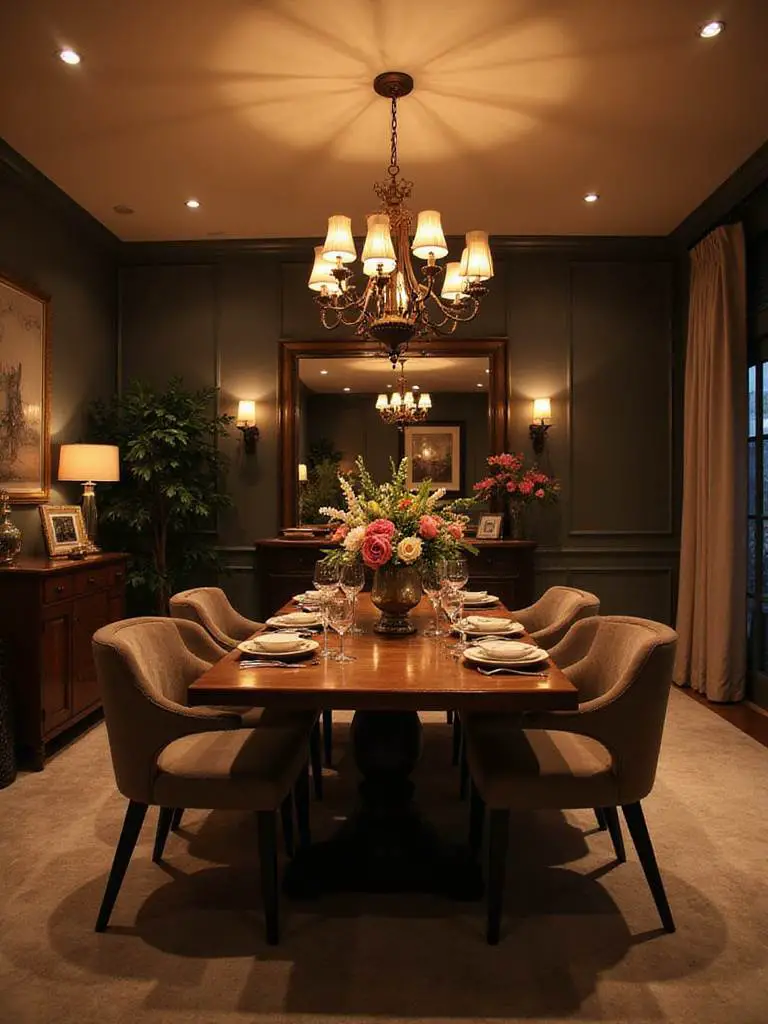
Smart dimmer switches offer unprecedented control over your dining environment. Program custom scenes that automatically adjust your lighting for specific activities—a “Dinner Party” setting that reduces overhead lighting to 60% while maintaining accent lighting, or a “Cleanup” mode that brings everything to full brightness. These programmable options eliminate the guesswork from creating the perfect ambiance for any occasion.
The key to successful dimming lies in selecting compatible components. LED bulbs require specific dimmer types to prevent flickering or buzzing, while some fixtures need particular wiring configurations. Investing in high-quality, LED-compatible dimmers ensures smooth, silent operation that enhances rather than detracts from your dining experience.
- Choose LED-compatible dimmers: Prevent flickering and extend bulb lifespan
- Consider smart controls: Program custom scenes for different dining occasions
- Install multiple circuits: Control overhead and accent lighting independently
The designer’s secret here is to layer your dimming capabilities—controlling different light sources independently creates depth and sophistication in your lighting scheme.
6. Choose Fixture Styles That Enhance Your Design Story
Your dining room lighting over table serves as the crown jewel of your dining space, anchoring the room’s aesthetic while reflecting your personal design sensibilities. The style you choose should feel like a natural extension of your room’s existing character, whether that’s sleek contemporary minimalism, warm traditional elegance, or eclectic bohemian charm. This fixture becomes a defining element that guests notice immediately upon entering your dining space.
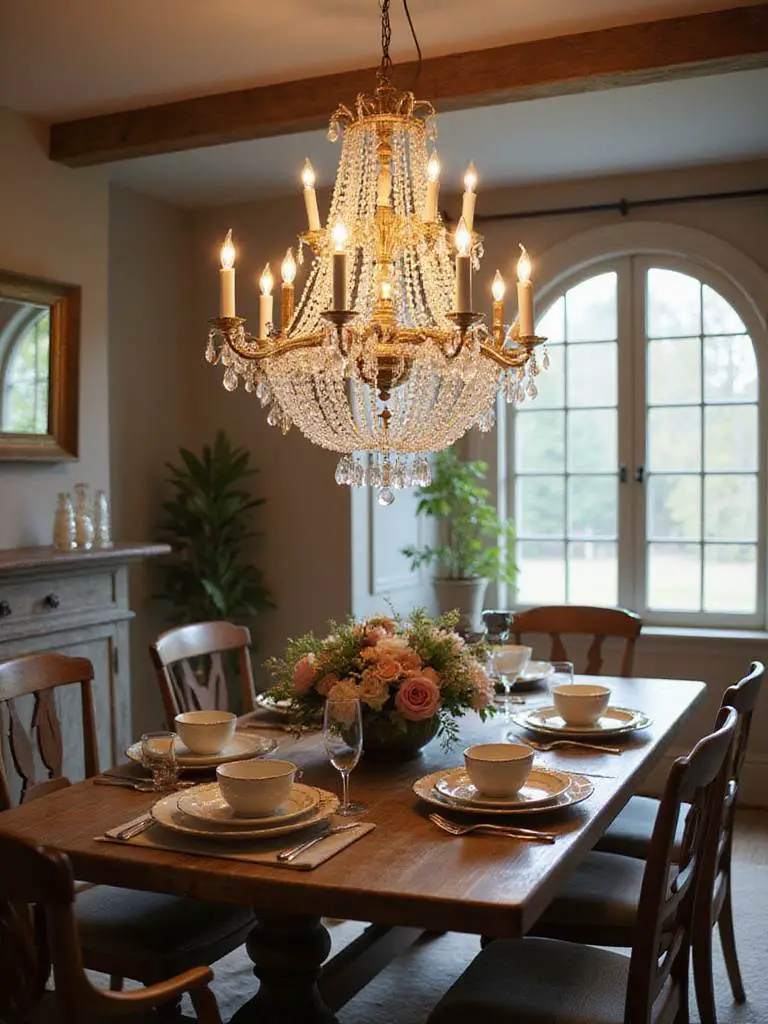
Contemporary spaces benefit from clean-lined fixtures with geometric forms and mixed materials like brushed metal and glass. Traditional rooms come alive with classic chandeliers featuring crystal accents or elegant candelabra-style arms. For transitional spaces that blend multiple styles, consider fixtures that incorporate both modern and traditional elements—perhaps a classic silhouette rendered in contemporary materials.
The most successful fixture choices create dialogue with existing room elements rather than competing for attention. A rustic wooden beam ceiling calls for fixtures that acknowledge this architectural feature, while a room filled with vintage artwork might welcome a fixture that adds contemporary contrast. The goal is creating layers of visual interest that feel intentional and cohesive.
- Assess your dominant style: Identify whether your space leans traditional, contemporary, or transitional
- Consider material harmony: Match or thoughtfully contrast with existing metals and finishes
- Think beyond trends: Choose pieces that will feel relevant for years to come
The artisan collective that creates these pieces understands that lighting fixtures must serve both functional and sculptural roles in your dining space.
7. Embrace Multiple Pendants for Contemporary Focus
The evolution of dining room lighting over table has embraced the sophisticated approach of multiple pendant lights, offering superior light distribution and striking visual impact. This contemporary strategy allows you to create focused pools of light exactly where needed while establishing a modern, gallery-like aesthetic. Multiple pendants work particularly well over long tables or in spaces where you want to create distinct zones within your dining area.
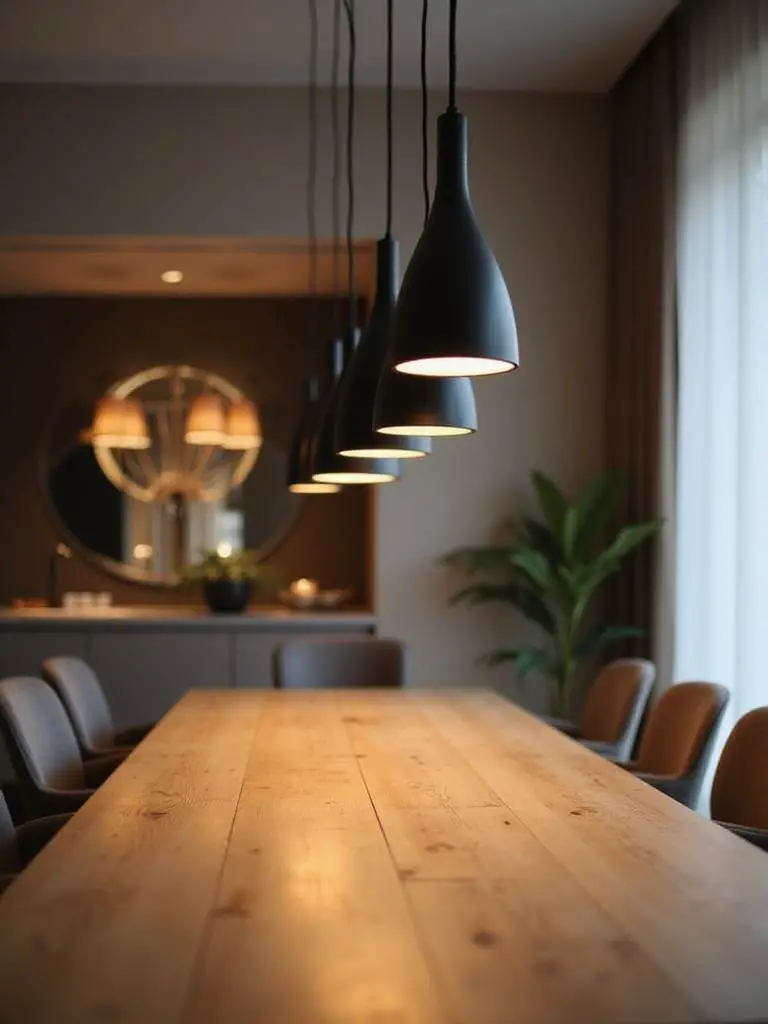
Three to five pendants arranged in a linear formation provide even illumination across extended dining surfaces while creating dramatic visual rhythm. The spacing between fixtures—typically 24 to 30 inches apart—ensures consistent light coverage without creating harsh shadows or dead zones. This approach also offers the flexibility to control individual pendants or group them together, providing nuanced lighting options for different occasions.
The beauty of this arrangement lies in its scalability and customization potential. Varying the heights slightly creates dynamic visual interest, while maintaining consistent spacing ensures functional effectiveness. Consider pendants with adjustable cord lengths that allow you to fine-tune the composition after installation, accommodating both your aesthetic preferences and practical lighting needs.
- Plan for proper spacing: 24-30 inches between fixtures ensures even coverage
- Consider adjustable heights: Slight variations create visual dynamism
- Choose cohesive styles: Multiple pendants should feel like a coordinated family
Beyond the obvious placement, consider using this approach to define specific areas within larger open-plan spaces, creating intimate dining zones.
8. Utilize Linear Fixtures for Extended Table Coverage
When your dining table extends beyond six feet in length, linear fixtures become essential for achieving uniform dining room lighting over table coverage. These elongated light sources eliminate the common problem of dark spots at table ends while creating a sophisticated, contemporary aesthetic. Linear fixtures range from sleek LED strips to elegant multi-bulb chandeliers that span your table’s length proportionally.
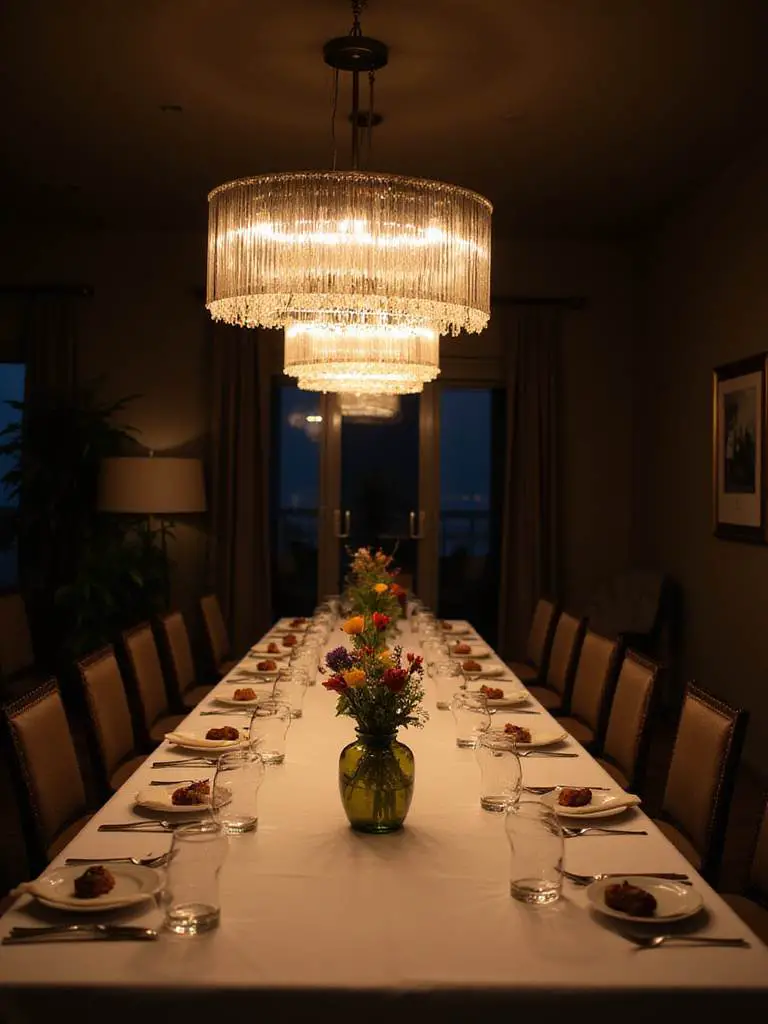
The ideal linear fixture measures between half and two-thirds of your table’s length, ensuring comprehensive light coverage without overwhelming the space. A nine-foot table pairs beautifully with a five to six-foot linear chandelier, creating balanced proportions while delivering consistent illumination from end to end. This approach prevents the spotlight effect that single fixtures often create over lengthy surfaces.
Modern linear LED fixtures offer particular advantages, including energy efficiency, longevity, and the ability to integrate dimming controls seamlessly. Many contemporary designs feature adjustable color temperature, allowing you to shift from crisp daylight for tasks to warm amber for dining. This technological sophistication combined with sleek aesthetics makes linear fixtures an increasingly popular choice for design-conscious homeowners.
- Match fixture length to table proportions: Aim for 50-65% of table length
- Consider integrated LED options: Modern efficiency with sophisticated controls
- Plan for proper mounting: Ensure adequate ceiling support for extended fixtures
The craftsmanship in this collection tells a story of precision engineering meeting aesthetic refinement, creating fixtures that perform as beautifully as they appear.
9. Coordinate Fixture Shapes with Table Geometry
The harmony between your dining room lighting over table fixture shape and your table’s geometry creates visual coherence that feels naturally balanced and intentionally designed. This principle extends beyond mere aesthetics—properly matched shapes ensure optimal light distribution while reinforcing your room’s design logic. Round tables pair beautifully with circular or radially symmetrical fixtures, while rectangular surfaces call for linear or elongated lighting solutions.
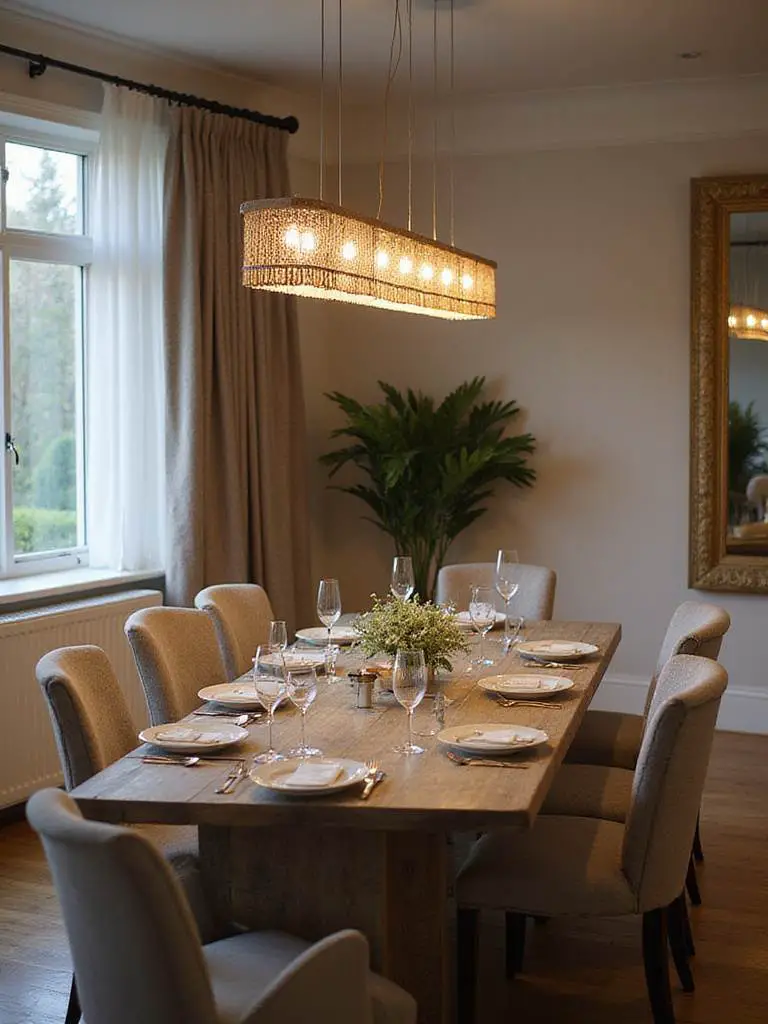
Oval tables present unique opportunities for creative fixture selection. A linear chandelier that echoes the table’s elongated form creates sophisticated harmony, while a large round fixture positioned at the table’s center can provide dramatic contrast. The key lies in understanding how these shapes interact visually and functionally, ensuring your lighting choice enhances rather than conflicts with your table’s proportions.
Consider the visual weight and complexity of both elements when making your selection. A simple, clean-lined table can support a more ornate fixture, while an elaborately detailed table might benefit from understated lighting that doesn’t compete for attention. This balance creates depth and interest without visual chaos.
- Echo primary shapes: Round tables with circular fixtures, rectangular with linear
- Consider proportional relationships: Fixture size should complement table scale
- Balance visual complexity: Simple tables can support ornate fixtures and vice versa
The silhouette draws inspiration from architectural principles that celebrate the beauty of geometric harmony in residential spaces.
10. Layer Multiple Light Sources for Dynamic Ambiance
Exceptional dining room lighting over table extends beyond a single overhead fixture to embrace the sophisticated concept of layered illumination. This approach combines ambient, task, and accent lighting to create a flexible, dynamic environment that adapts to your changing needs throughout the day. Wall sconces, table lamps, and recessed lighting work together to eliminate harsh shadows while providing the versatility essential for modern living.
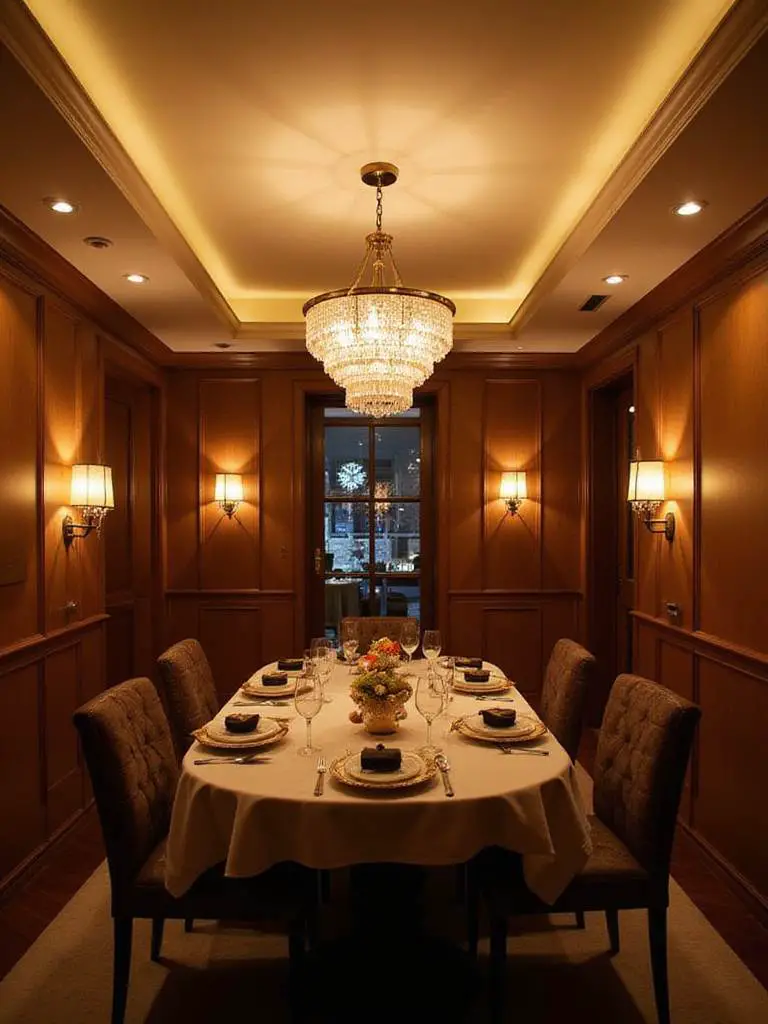
Ambient lighting establishes your room’s overall illumination level, typically provided by your central fixture operating at reduced intensity. Task lighting focuses on specific activities—perhaps under-cabinet strips that illuminate a buffet area or picture lights that showcase artwork. Accent lighting adds drama and visual interest, highlighting architectural features or creating intimate conversation areas within the larger space.
The magic happens when these layers work in concert, controlled by separate dimmers that allow infinite customization. A dinner party might call for reduced overhead lighting with enhanced accent illumination, while homework time requires bright, even task lighting. This flexibility transforms your dining room from a single-purpose space into a multi-functional environment that serves your family’s diverse needs.
- Establish three distinct layers: Ambient, task, and accent lighting working together
- Install independent controls: Separate dimmers for each lighting layer
- Consider portable options: Table lamps and floor lamps add flexibility without rewiring
The mood shifts dramatically when you add these supplementary light sources, creating depth and sophistication that single-source lighting cannot achieve.
11. Eliminate Glare Through Strategic Shade Selection
The comfort of your dining room lighting over table depends heavily on preventing harsh glare that can make dining uncomfortable and conversation difficult. Strategic shade selection and bulb choices work together to diffuse light effectively while maintaining adequate illumination levels. Opaque or frosted materials shield direct bulb visibility while directing light downward and outward in controlled patterns.
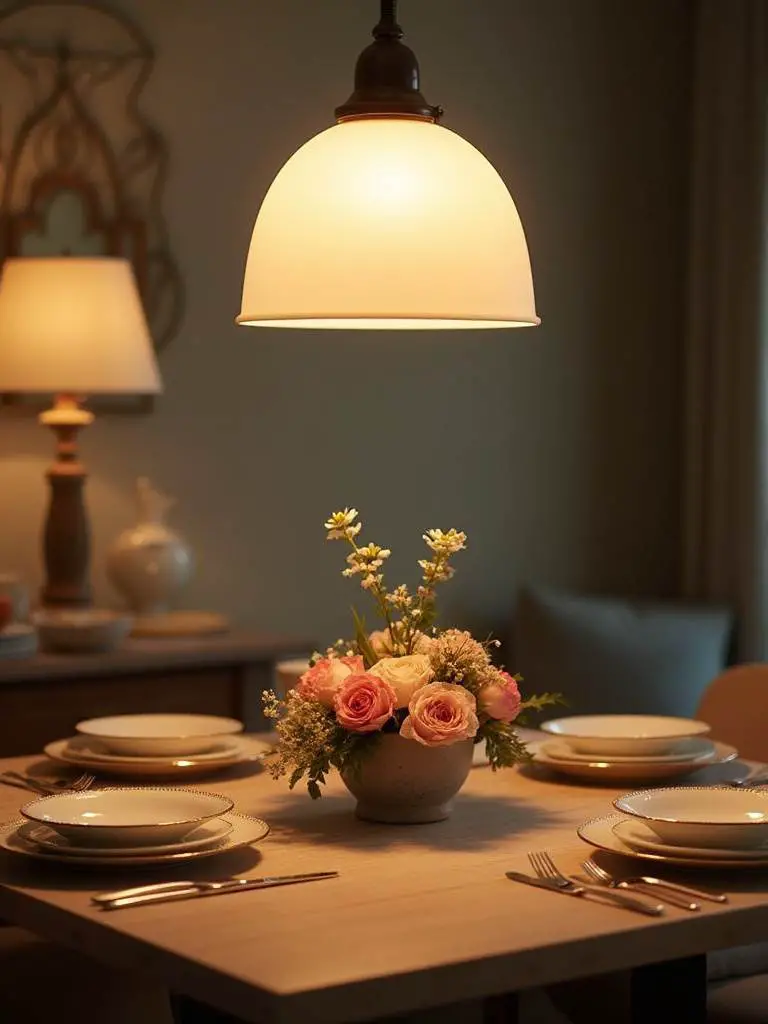
Fabric shades provide excellent diffusion while adding textural warmth to your lighting design. Drum shades, empire shapes, and contemporary geometric forms all offer different light distribution patterns while concealing bright bulb surfaces. Glass shades work similarly, with frosted or etched surfaces scattering light to prevent harsh spotting while maintaining the fixture’s visual lightness.
The relationship between shade design and bulb selection significantly impacts glare control. Even with excellent shades, exposed filament bulbs or high-wattage sources can create uncomfortable brightness. Frosted LED bulbs paired with well-designed shades provide optimal comfort, delivering ample illumination without the harsh edges that make dining unpleasant.
- Choose opaque or frosted materials: Shield direct bulb visibility from dining positions
- Consider shade depth: Deeper shades provide better glare control
- Match bulb finish to shade design: Frosted bulbs work best with most shade types
Unlike mass-produced alternatives, this technique allows for precise control over light quality and distribution, ensuring dining comfort.
12. Upgrade to LED Technology for Efficiency and Quality
Modern dining room lighting over table benefits tremendously from LED technology’s superior efficiency, longevity, and light quality characteristics. These advanced light sources consume up to 85% less energy than traditional incandescent bulbs while lasting 25 times longer, dramatically reducing both operating costs and maintenance requirements. For dining applications, high-quality LEDs provide exceptional color rendering that makes food appear vibrant and appetizing.
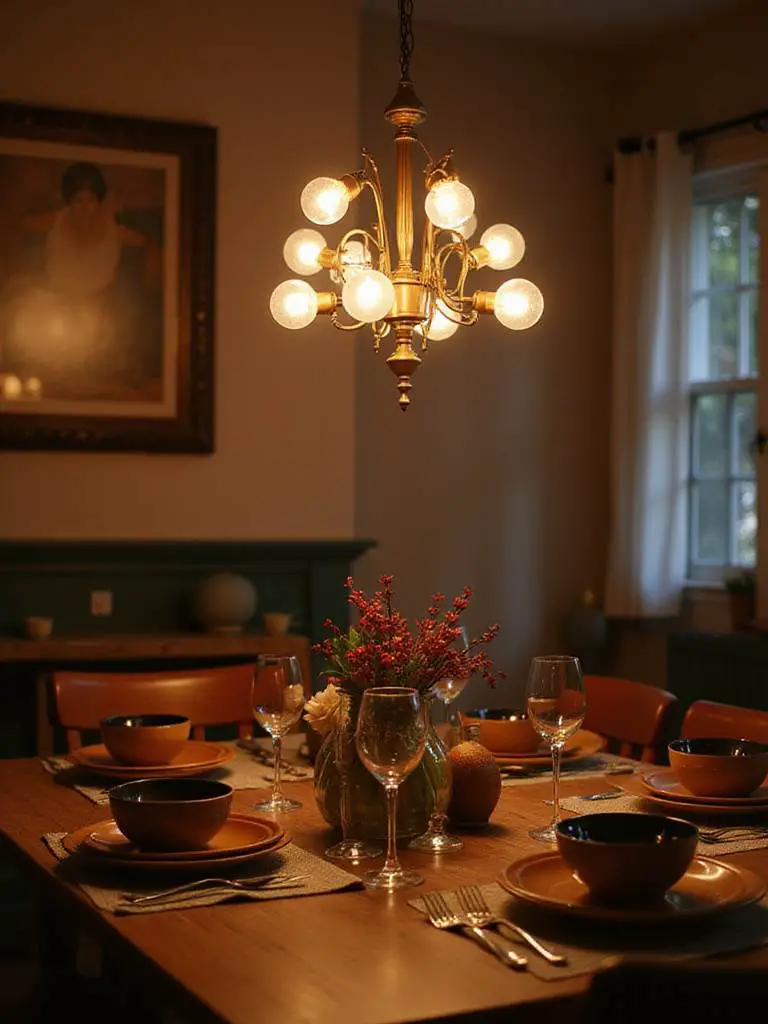
The key to successful LED integration lies in selecting bulbs with appropriate specifications for dining environments. Look for Color Rendering Index (CRI) ratings above 90, which ensure accurate color representation of food and decor. Warm color temperatures between 2700K and 3000K create the inviting atmosphere essential for comfortable dining while maintaining sufficient clarity for practical tasks.
Dimming compatibility represents another crucial consideration when upgrading to LEDs. Many older dimmer switches cause LED bulbs to flicker or buzz, requiring updates to LED-compatible controls. Modern smart dimmers offer additional benefits, including programmable scenes and remote control capabilities that enhance your lighting system’s versatility and convenience.
- Prioritize high CRI ratings: 90+ ensures accurate color representation
- Verify dimming compatibility: Update controls to prevent flickering
- Consider smart integration: Modern controls offer enhanced functionality
The sustainable journey of this material involves reducing energy consumption while improving light quality, demonstrating how environmental responsibility enhances rather than compromises performance.
13. Ensure Professional Installation for Safety and Precision
The success of your dining room lighting over table project depends critically on proper installation that prioritizes both safety and aesthetic precision. Electrical work requires careful attention to circuit capacity, junction box ratings, and local code compliance. Heavy fixtures demand adequate structural support, while precise positioning ensures optimal light distribution and visual balance within your dining space.
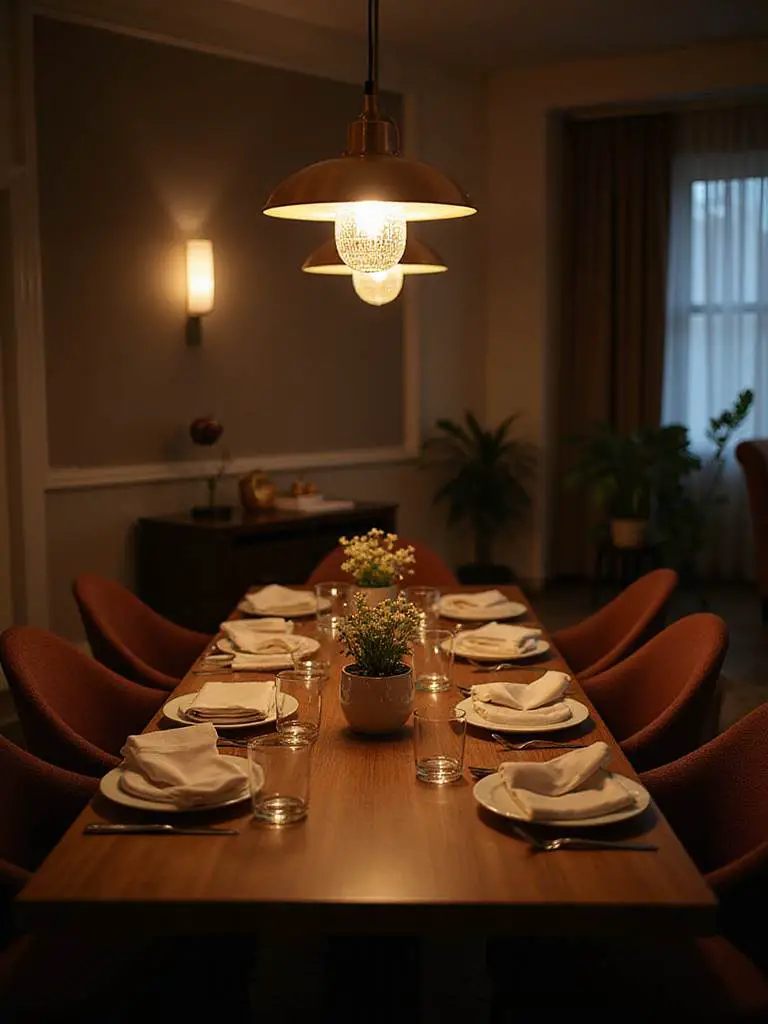
Professional installation becomes particularly important for complex fixtures or homes with older electrical systems. Chandeliers exceeding 50 pounds require specialized mounting hardware and potentially additional ceiling reinforcement. Smart lighting systems involve sophisticated wiring that benefits from expert knowledge of control integration and wireless connectivity requirements.
The precision aspect of installation extends beyond safety to encompass the visual perfection that makes your lighting investment worthwhile. Exact centering over your table, proper height adjustment, and level mounting all contribute to the polished appearance that distinguishes professional results from amateur attempts. These details significantly impact both function and aesthetics.
- Verify electrical capacity: Ensure circuits can handle new fixture loads
- Check structural support: Heavy fixtures require proper mounting hardware
- Prioritize precise positioning: Exact centering and height matter significantly
The construction technique that ensures longevity involves proper electrical connections and structural mounting that will serve your family safely for decades.
14. Integrate Wall Sconces for Enhanced Atmospheric Control
Supplementing your central dining room lighting over table fixture with wall sconces creates the layered lighting essential for sophisticated ambiance control. These mid-level light sources eliminate harsh shadows while providing the flexibility to adjust your room’s character for different occasions. Sconces work particularly well for highlighting artwork, architectural features, or creating intimate conversation areas within larger dining spaces.
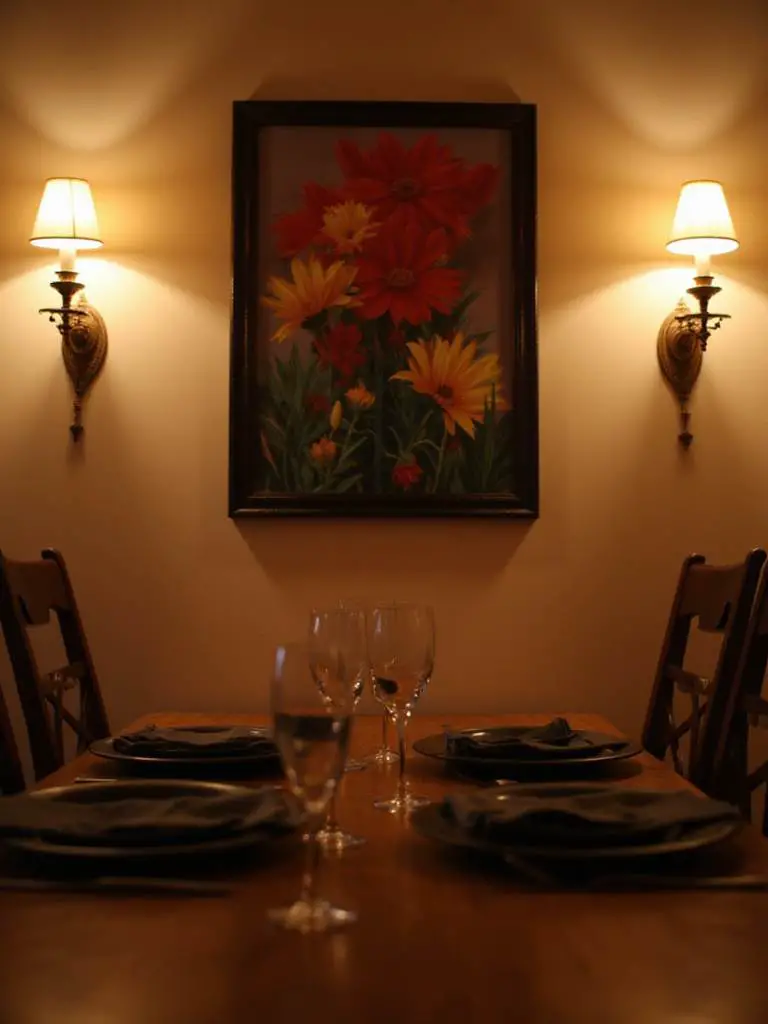
Strategic sconce placement typically involves mounting fixtures at eye level—approximately 60 to 66 inches from the floor—on walls that frame your dining area. Pairs of sconces flanking a buffet or artwork create balanced illumination while adding visual interest to vertical surfaces. The key lies in selecting fixtures that complement your central lighting while providing independent control through separate dimming circuits.
The integration of sconces with your overall lighting scheme allows for nuanced atmosphere creation that single-source lighting cannot achieve. Bright overhead lighting with subtle sconce illumination works well for family meals, while dimmed overhead lighting with enhanced sconce output creates intimate dinner party ambiance. This flexibility transforms your dining room into a truly adaptable space.
- Mount at appropriate heights: 60-66 inches from floor for optimal illumination
- Create balanced arrangements: Pairs or odd-numbered groupings work best
- Install independent controls: Separate dimmers enable sophisticated lighting scenes
The visual weight balances perfectly when you combine overhead and wall-mounted sources, creating depth and sophistication in your lighting design.
15. Scale Fixtures Appropriately for Ceiling Height
The relationship between your dining room lighting over table fixture and ceiling height significantly impacts both visual proportion and functional performance. Standard eight-foot ceilings require different fixture considerations than soaring ten or twelve-foot spaces. Proper scaling ensures your lighting feels proportionate to the room’s volume while maintaining appropriate hanging heights for comfort and functionality.
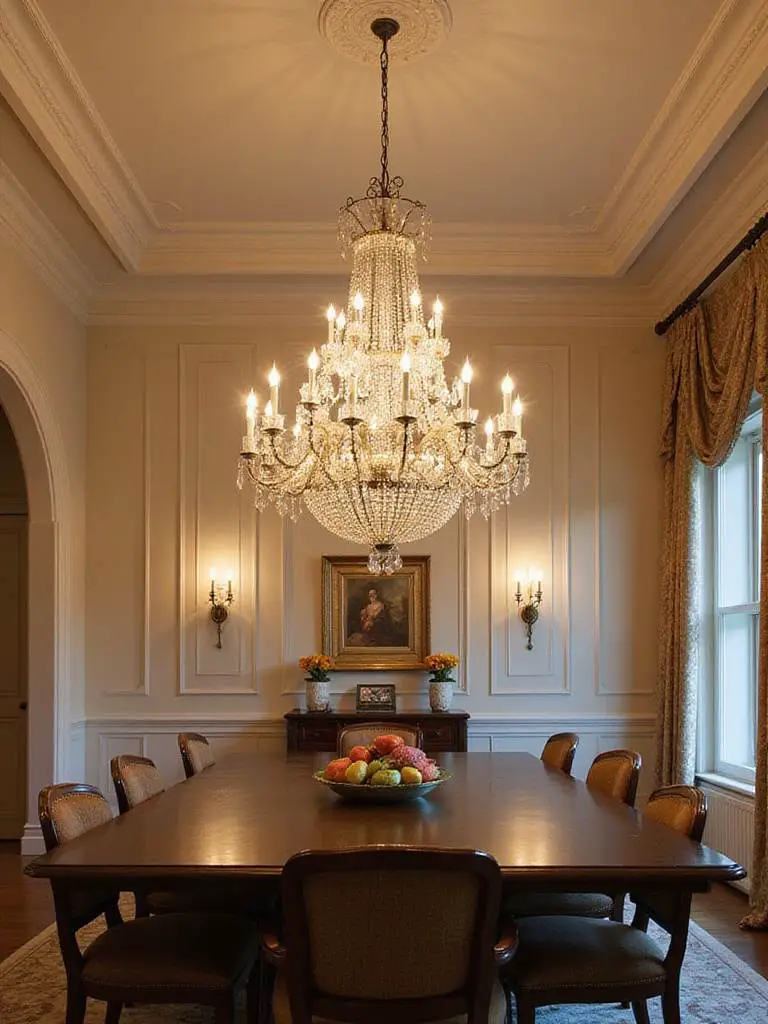
High ceilings offer opportunities for dramatic fixtures with substantial vertical presence. Large multi-tier chandeliers, extended pendant arrangements, or fixtures with significant drop length can fill vertical space effectively while creating impressive focal points. The additional height also allows for more flexible positioning, as fixtures can hang lower while maintaining adequate clearance for movement and conversation.
Low ceilings present different challenges, often requiring flush-mount or semi-flush fixtures that provide adequate illumination without overwhelming the space. These constraints demand careful attention to fixture selection, ensuring sufficient light output while maintaining visual appeal. Creative solutions might include recessed lighting combined with decorative ceiling medallions or low-profile fixtures with wide light distribution patterns.
- Adjust for ceiling height: Higher ceilings accommodate larger, more dramatic fixtures
- Maintain proper clearances: Ensure adequate headroom for comfortable movement
- Consider fixture proportions: Match vertical scale to room volume
The environmental story behind this piece began with understanding how ceiling height affects both light distribution and visual impact in residential spaces.
16. Coordinate Materials for Design Cohesion
The materials and finishes of your dining room lighting over table fixture should create harmonious dialogue with your existing decor elements. This coordination extends beyond simple matching to encompass thoughtful relationships between metals, woods, fabrics, and glass surfaces throughout your dining space. Successful material coordination creates visual flow while allowing your lighting fixture to feel like an integral part of your room’s design story.
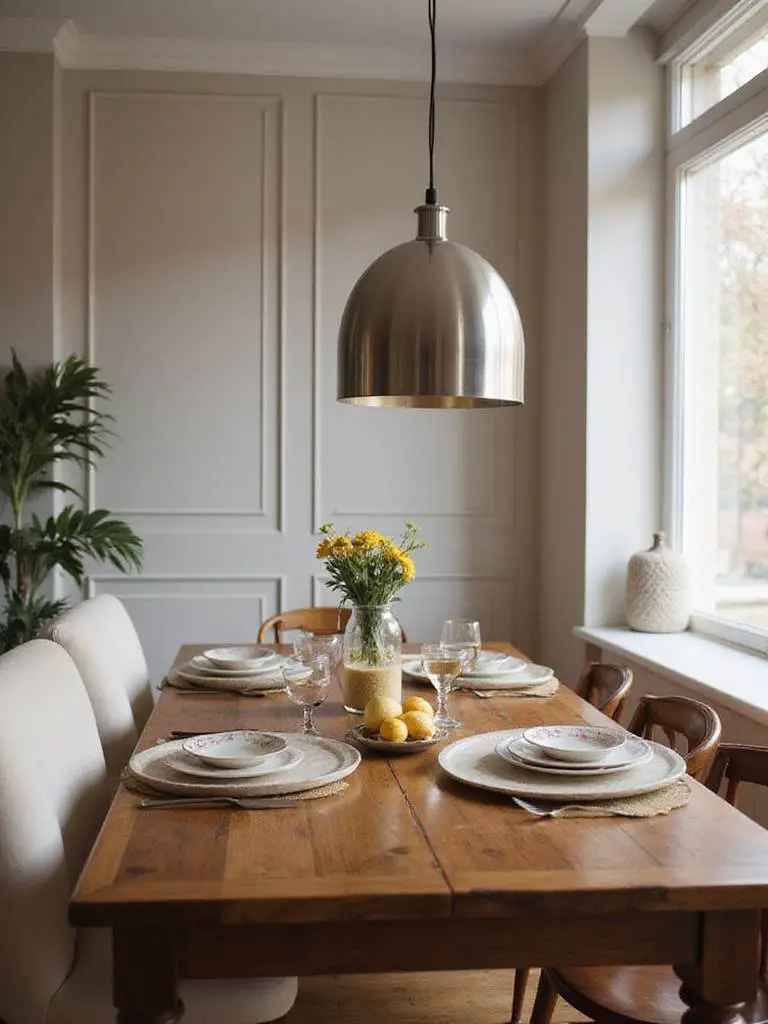
Contemporary spaces often feature mixed metals that create sophisticated contrast—perhaps brushed nickel fixtures complementing warm brass cabinet hardware, or matte black lighting paired with polished chrome accents. The key lies in establishing a consistent material palette that includes two to three primary finishes used consistently throughout the space. This approach prevents visual chaos while maintaining design interest.
Traditional and transitional spaces benefit from material harmony that reinforces established design themes. Warm wood tones in furniture might inspire fixtures with wooden accents or warm metal finishes. Crystal or glass elements can echo similar materials used in accessories or architectural features, creating subtle connections that enhance overall design cohesion.
- Establish a consistent palette: Limit primary materials to 2-3 finishes
- Consider mixed metals: Thoughtful contrast can enhance contemporary designs
- Echo existing elements: Connect lighting materials to furniture and architectural features
The heritage technique gets a contemporary update through careful material selection that honors traditional craftsmanship while embracing modern functionality.
17. Maintain Fixtures for Optimal Performance
Consistent maintenance keeps your dining room lighting over table performing at peak efficiency while preserving its aesthetic appeal. Dust, cooking residue, and environmental particles accumulate on fixtures over time, reducing light output by up to 30% while diminishing visual sparkle. Regular cleaning schedules ensure your lighting investment continues delivering optimal illumination and visual impact throughout its lifespan.
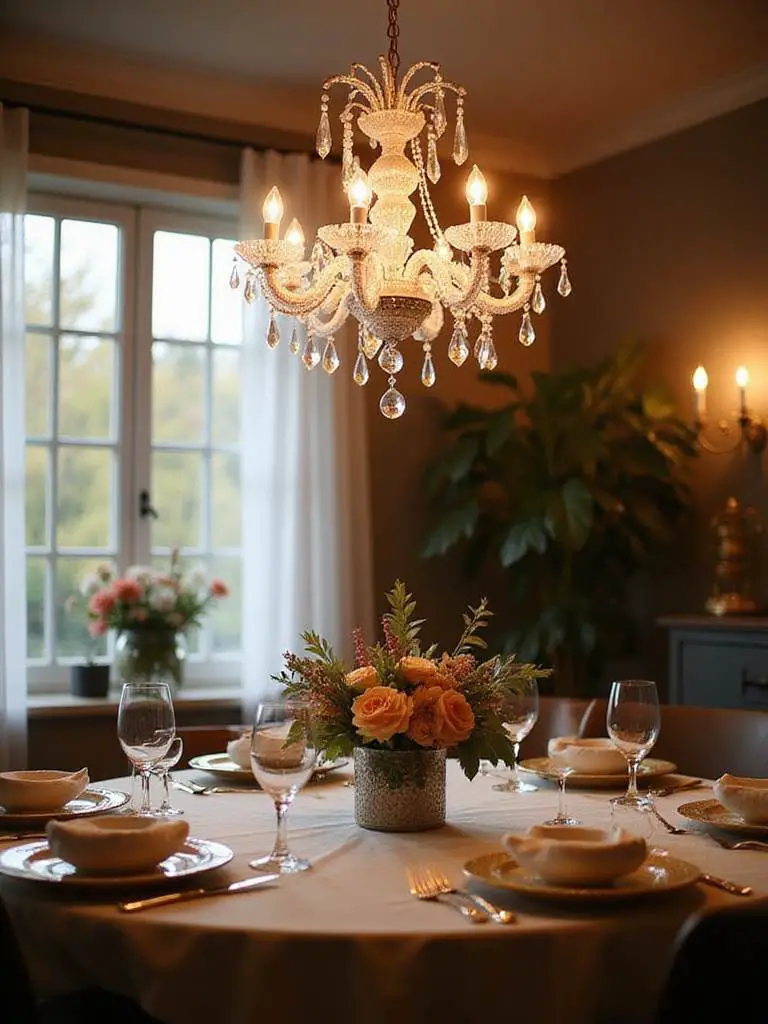
Monthly dusting with microfiber cloths removes surface accumulation before it becomes problematic, while quarterly deep cleaning addresses more stubborn buildup. Different fixture materials require specific cleaning approaches—crystal elements benefit from specialized cleaners, while metal surfaces need appropriate products that won’t damage finishes. Always ensure power is disconnected before beginning any cleaning procedures.
The relationship between cleanliness and performance extends beyond mere aesthetics to encompass energy efficiency and bulb longevity. Clean fixtures operate more efficiently, reducing energy consumption while preventing heat buildup that can shorten LED lifespan. This maintenance attention protects your investment while ensuring consistent lighting quality for your dining experiences.
- Establish regular schedules: Monthly dusting and quarterly deep cleaning
- Use appropriate materials: Microfiber cloths and fixture-specific cleaners
- Prioritize safety: Always disconnect power before cleaning procedures
The quality becomes evident after years of use when properly maintained fixtures continue delivering exceptional performance and visual appeal.
18. Avoid Common Design Mistakes That Compromise Function
Even with careful planning, certain mistakes can undermine your dining room lighting over table effectiveness and aesthetic appeal. Understanding these common pitfalls helps ensure your lighting project achieves its full potential while avoiding costly corrections later. The most frequent errors involve improper sizing, inadequate height adjustment, and over-reliance on single light sources without flexibility controls.
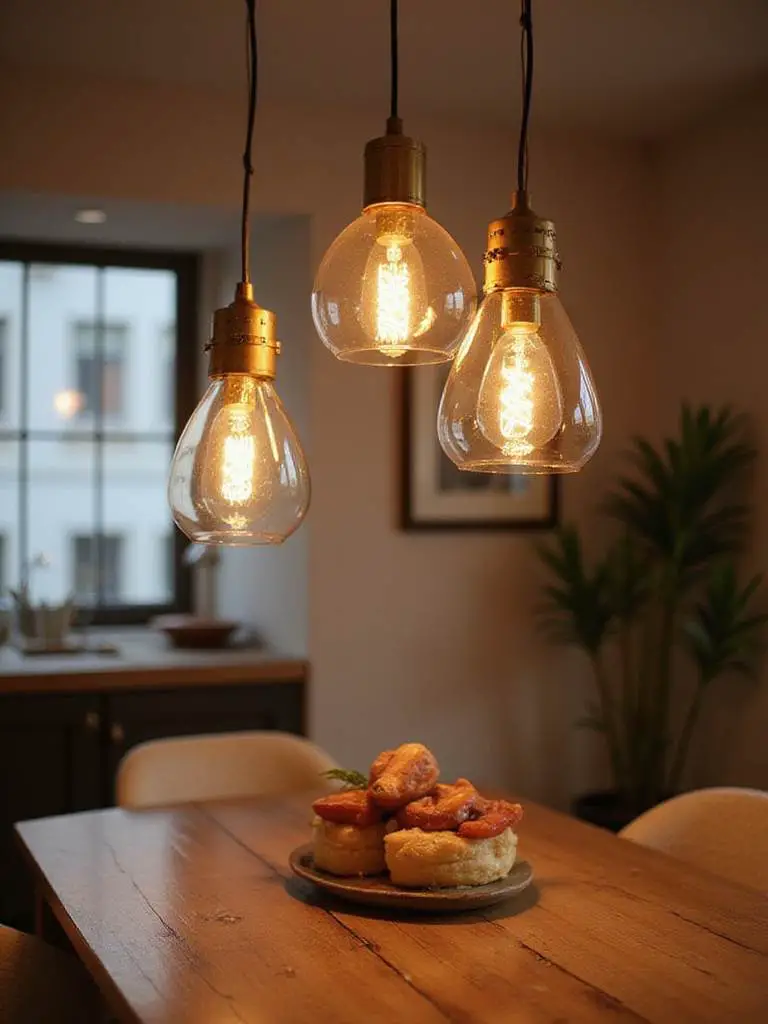
Fixture sizing mistakes often stem from focusing solely on room dimensions rather than table proportions. A fixture that looks appropriate for your room’s square footage might overwhelm or underwhelm your specific table size. Similarly, height positioning errors create either uncomfortable glare from fixtures hung too low or inadequate illumination from those positioned too high. These fundamental mistakes compromise both comfort and functionality.
The third critical error involves installing beautiful fixtures without dimming controls or supplementary lighting sources. This limitation creates inflexible spaces that can only operate at full brightness or complete darkness, missing the nuanced ambiance control that makes dining rooms truly functional for modern families. Smart planning prevents these limitations while maximizing your lighting investment’s versatility.
- Size for table proportions: Consider table dimensions, not just room size
- Test height positioning: Verify comfort from all seating positions before finalizing
- Plan for flexibility: Include dimming controls and supplementary light sources
The styling mistake most people make is treating dining room lighting as purely decorative rather than recognizing its crucial role in creating functional, adaptable spaces.
Conclusion
Creating exceptional dining room lighting over table transforms more than just visibility—it elevates every moment shared around your dining surface into something memorable and meaningful. Through these eighteen essential strategies, you’ve discovered how thoughtful lighting design encompasses everything from precise measurements and technical specifications to the subtle artistry of layered illumination and atmospheric control. Each element works in harmony to create spaces that adapt seamlessly to your family’s evolving needs.
The journey from basic illumination to sophisticated lighting design requires attention to proportion, technology, and the human experience of dining together. Whether you’re implementing energy-efficient LEDs, coordinating materials with your existing decor, or mastering the nuanced control that dimming systems provide, every decision contributes to creating an environment that enhances both daily meals and special celebrations. The most successful dining rooms recognize that lighting serves both functional and emotional purposes, supporting everything from homework sessions to anniversary dinners.
Your dining room awaits its transformation into a luminous haven that reflects your personal style while serving your family’s practical needs. Take these insights, apply them thoughtfully to your unique space, and prepare to experience how exceptional dining room lighting over table can redefine your home’s most important gathering place. The perfect balance of beauty, functionality, and atmosphere is within your reach—let your newly illuminated dining room become the radiant heart of your home.
